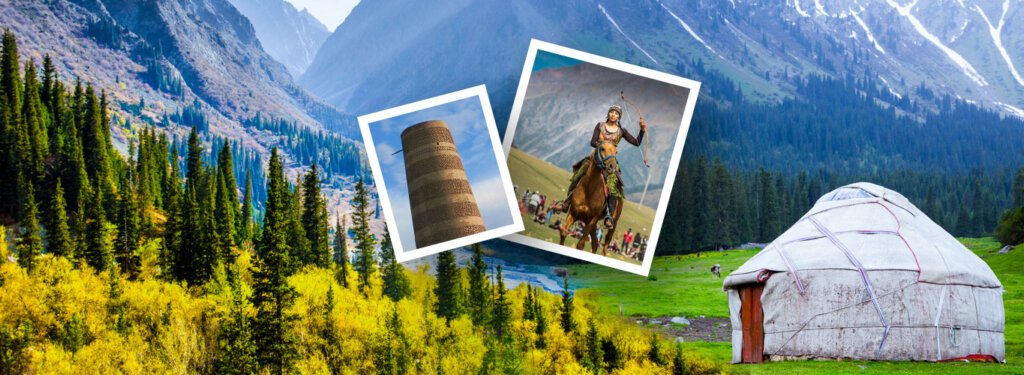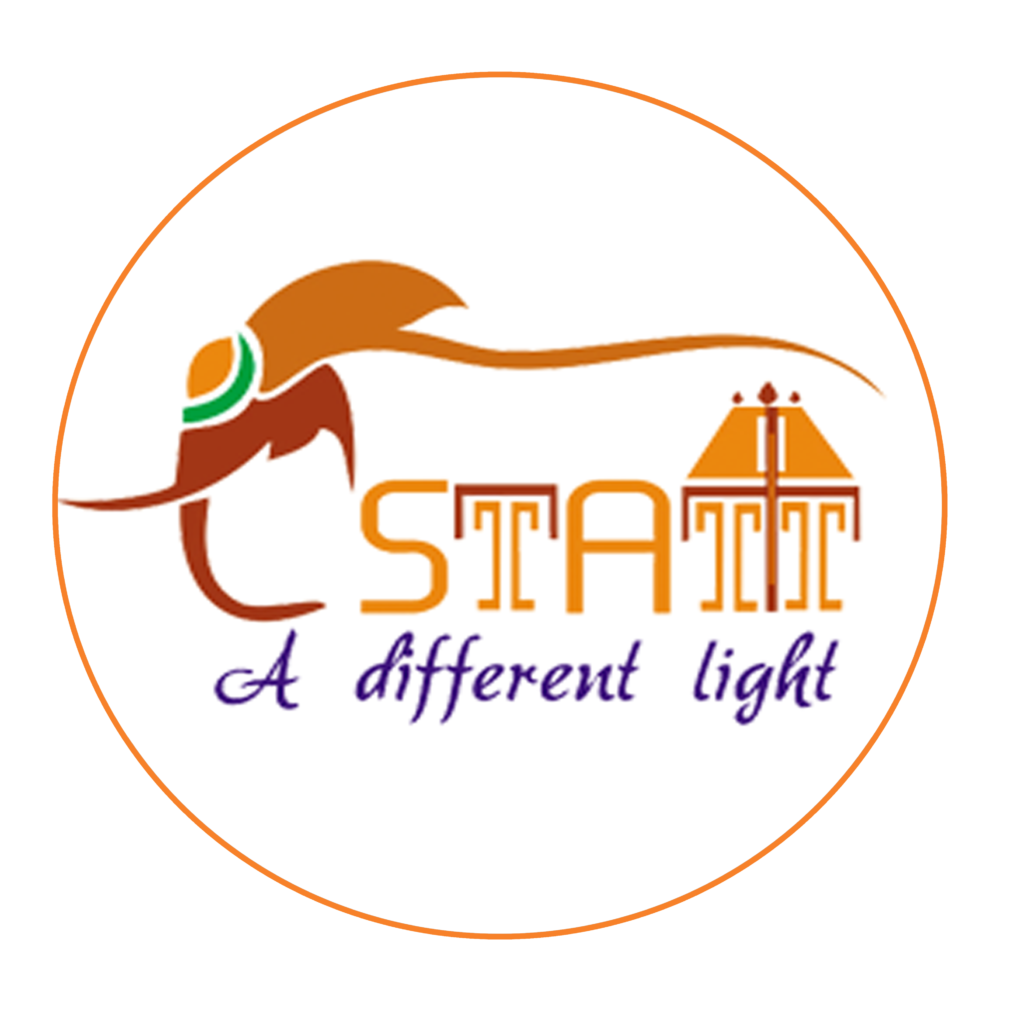
South India's No. 1 Travel Agency ✨
💱 Currency
Kyrgyzstani Som (KGS)
🗣️ Languages
Kyrgyz (official)
🌤️ Climate
-15°C to 35°C (extreme cold in winter, warm summers)
📅 Best Season
June – September (trekking & outdoor)
December – February (winter adventures)
🛡 Must-Know Travel Tips for Visiting Kyrgyzstan
- 🏧 ATMs are available in major cities, but may not be reliable in rural or mountainous areas — carry enough cash when heading off-grid.
- 💳 Credit cards are accepted in urban centers like Bishkek and Osh, but cash (KGS) is preferred in local markets and small towns.
- 🏦 Banks usually operate from Monday to Friday (9 AM to 5 PM); ATMs are accessible 24/7 in cities, but less so in remote areas.
- 🍷 The legal drinking age in Kyrgyzstan is 18.
- 🤝 Kyrgyz people are hospitable and respectful — greet with a handshake and remove shoes when entering homes.
- 💰 Kyrgyzstan is very affordable; prices remain steady, but travel costs can be lower during shoulder seasons (May–June, September).
What Is Kyrgyzstan Famous For? – About Kyrgyzstan Explained
Kyrgyzstan is famous for its epic mountain landscapes, nomadic heritage, and unspoiled wilderness. Many Indian travelers are now discovering this hidden Central Asian gem through carefully curated Kyrgyzstan tour packages that highlight both nature and culture.
Often called the “Switzerland of Central Asia,” the country offers awe-inspiring natural scenery dominated by the Tien Shan and Pamir-Alay mountain ranges, which make up nearly 90% of the land. These ranges are home to snow-capped peaks, high-altitude lakes, alpine meadows, and deep gorges—creating a dream destination for trekkers, climbers, and nature photographers. One of the most iconic natural landmarks is Lake Issyk-Kul, a massive, saltwater lake ringed by mountains. Despite its altitude of over 1,600 meters, it never freezes, earning its name “Issyk-Kul,” meaning “warm lake.” The lake is ideal for water sports, beach relaxation, and soaking in hot springs, making it a favorite for both domestic and international tourists.Kyrgyzstan’s fame also stems from its nomadic traditions, which remain vibrantly alive. From staying in felt yurts on remote pastures called jaloos to witnessing traditional horse games like Kok Boru or Er Enish, visitors can experience centuries-old customs firsthand. The World Nomad Games, held periodically in Kyrgyzstan, have brought international attention to these traditions.The country is also part of the ancient Silk Road, and its cities like Osh—one of the oldest in Central Asia—carry the legacy of this historic trade route.Kyrgyzstan’s markets, especially the vibrant Osh Bazaar in Bishkek, burst with color and energy, offering a true glimpse into the bustling heart of Central Asian commerce.Additionally, Kyrgyzstan is known for its ecotourism appeal and sustainability focus. The country is also recognized for its mountaineering potential, including peaks like Lenin Peak, which rises to 7,134 meters. It is respected as a peaceful and relatively stable democracy in the region. As a hidden gem in Asia, Kyrgyzstan offers a raw and authentic travel experience that’s off the beaten path—ideal for adventure lovers, cultural enthusiasts, and anyone seeking solitude in nature.
Kyrgyzstan Tour Packages
Most Chosen Kyrgyzstan Plans by Our Happy Customers
How Are India and Kyrgyzstan Connected? – Cultural & Historical Ties
The connection between India and Kyrgyzstan stretches back to the Silk Road era, when Central Asian traders and pilgrims traveled through the Indian subcontinent. This historical corridor of commerce and culture fostered centuries of interaction between the peoples of the two regions.
In modern times, the relationship has grown substantially. Diplomatic ties between India and Kyrgyzstan were officially established in 1992, and since then, both countries have enjoyed warm bilateral relations that span multiple sectors—education, defense, healthcare, information technology, and culture.One of the most prominent connections is through education. Every year, thousands of Indian students enroll in Kyrgyz universities, particularly for MBBS (medical) studies. Universities like Osh State University and Kyrgyz State Medical Academy are popular choices due to their affordable fees, English-language instruction, and globally recognized degrees.Culturally, Kyrgyz people are highly receptive to Indian traditions. Bollywood movies, Indian classical dance, and yoga are widely appreciated, with local festivals often featuring Indian cultural performances. On the other hand, Indian travelers find comfort in Kyrgyz hospitality, shared respect for elders, and family values, which resonate with Indian culture.Tourism cooperation between the two countries is also on the rise, with both governments encouraging cross-border travel. There is strong military cooperation, especially in joint mountain warfare training. Both nations also participate in multilateral forums like the Shanghai Cooperation Organisation (SCO), where they collaborate on regional security and economic development. Air connectivity is gradually improving. Although there are no direct flights yet, Indian travelers can reach Kyrgyzstan via connections through cities like Delhi, Almaty, and Bishkek. With growing awareness and curiosity, Kyrgyzstan is becoming a popular destination for Indian travelers seeking new and culturally rich experiences.
Interesting Things to Know About Kyrgyzstan Before You Go
Before you pack your bags for Kyrgyzstan, it’s helpful to understand a few fascinating facts and essential travel tips to make the most of your trip.Kyrgyzstan is one of the few places where nomadic traditions are not just preserved—they’re practiced in daily life. In summer, many locals migrate to mountain pastures known as jailoos, where they live in yurts, raise animals, and maintain centuries-old ways of life. Travelers can stay in these yurts, enjoy traditional dishes like boorsok (fried dough) and kumis (fermented mare’s milk), and even join locals for horseback treks. For nature enthusiasts, Kyrgyzstan is nothing short of a dream destination. Whether it’s hiking to Ala-Kul Lake, riding horses through the plains of Song-Kul, skiing in Karakol, or visiting the colorful rock formations of Skazka Canyon, the nature here is wild and breathtaking. Many of these areas are remote and untouched by development, offering a rare glimpse into pristine ecosystems.
Indian travelers can apply for an e-visa online, and the process is usually fast and convenient. Kyrgyzstan has also signed agreements to simplify travel for Indian nationals, further enhancing accessibility.The food in Kyrgyzstan is hearty and flavorful, centered on meat, dairy, and bread. Some of the must-try dishes include beshbarmak (boiled meat with flat noodles), lagman (hand-pulled noodle soup), manti (steamed dumplings), and shashlik (grilled skewers). While vegetarian options may be limited in rural regions, larger cities like Bishkek and Osh have Indian restaurants and more diverse offerings to suit different palates.The local currency is the Kyrgyz Som (KGS), and prices are quite reasonable. A mid-range traveler can comfortably manage with INR 3,000–4,000 per day, including accommodation, meals, and local transport. While Wi-Fi is common in cities and cafes, it’s advisable to buy a local SIM card for internet access in remote areas.Kyrgyz and Russian are the main languages spoken, and English is not widely understood, particularly outside major cities. It’s a good idea to learn a few basic phrases or use a translation app for smoother communication.In terms of safety, Kyrgyzstan is very safe for tourists, including solo travelers. The people are known for their warm hospitality. It is common to be invited into homes for tea or a meal, even by strangers. As a visitor, it’s respectful to remove your shoes before entering a home, greet elders with politeness, and observe local customs.
What to Know Before Booking a Kyrgyzstan Tour Package
Booking a Kyrgyzstan tour package is an exciting step toward discovering one of Central Asia’s most stunning yet underrated destinations. However, understanding the nuances of travel here will help you choose the right package for your needs. Kyrgyzstan offers an adventurous, off-the-beaten-path experience, where ancient Silk Road history meets breathtaking alpine beauty and warm nomadic hospitality.
Indian citizens can enjoy up to 60 days of visa-free travel in Kyrgyzstan, though flight availability may be somewhat restricted. Most travelers enter via Bishkek’s Manas International Airport, often connecting through Dubai, Almaty, or Istanbul. When booking your tour, look for packages that include airport transfers and intercity travel, especially to mountain regions that may require private vehicles due to limited public transport. You can choose between group tours (more budget-friendly), private custom tours, or themed packages like trekking expeditions, yurt camping, cultural discovery, or wellness retreats by Issyk-Kul Lake. If you’re interested in horseback riding through the jailoos or participating in eagle hunting demonstrations, make sure these are part of your itinerary. While major cities like Bishkek and Osh offer modern hotels, rural areas provide homestays, guesthouses, and yurts—each offering a different experience. Some tour packages include meals, usually featuring traditional dishes like plov (pilaf), lagman (noodle soup), and manti (dumplings). Vegetarian options are available but should be requested in advance. Summer (June to September) is the most popular time to visit due to accessible high-altitude roads and warm temperatures. Spring (April–May) offers lush valleys and wildflowers, while winter draws skiers and snow lovers to Karakol and Jyrgalan. Always check if your tour operator adjusts the itinerary based on weather conditions. English isn’t widely spoken outside cities, so opt for a tour that provides local English-speaking guides who can bridge the cultural gap and enhance your understanding of Kyrgyz traditions, legends, and landscapes. Kyrgyzstan is generally safe, but it’s best to purchase travel insurance, especially if your itinerary includes trekking or adventure sports. It’s advisable to pack essential medicines, since access to pharmacies in remote regions of Kyrgyzstan can be scarce.
Which Are the Best Budget Kyrgyzstan Tour Packages?
Budget travel in Kyrgyzstan is surprisingly accessible and doesn’t mean compromising on authentic experiences or spectacular scenery. The country’s cost of living is low, and tour operators offer numerous budget-friendly itineraries perfect for Indian travelers seeking an affordable yet unforgettable escape.Most budget tours cover Bishkek, Issyk-Kul Lake, Karakol, and surrounding valleys like Jeti-Oguz or Chon-Kemin. These packages typically include scenic drives, short hikes, museum visits, cultural interactions with nomads, and visits to bustling local bazaars. Budget packages generally include airport transfers, accommodation (typically 2–3-star hotels or family-run guesthouses), shared transport, some meals, and the services of a bilingual guide. Accommodations in yurts or homestays can bring you closer to local life without breaking the bank.A sample 7-day itinerary might start with a city tour of Bishkek and a nature excursion to Ala Archa National Park. The tour then heads toward Issyk-Kul Lake with a stop at the historic Burana Tower. Afterward, it continues to Karakol and the red rock formations of Jeti-Oguz Canyon, followed by a visit to Fairy Tale Canyon and time to swim or relax by the lakeside. The return to Bishkek may include a scenic drive through Boom Gorge before concluding the journey with a farewell evening in the capital.Traveling in a group significantly lowers costs. Group tours (usually 8–12 people) are ideal for budget-conscious travelers and provide the added benefit of shared cultural experiences. Many Indian-focused operators now offer group departures from cities like Delhi or Mumbai with Hindi-speaking guides. Some budget tours offer optional add-ons like hot springs visits, folk shows, felt-making workshops, or horseback riding sessions for minimal extra cost. These activities add great value to your journey without putting a dent in your budget.When planning a budget-friendly Kyrgyzstan tour plan, it’s important to consider the balance between cultural depth and affordability—many curated packages allow travelers to explore scenic landscapes, local food, and nomadic traditions without overspending.
Quick Facts About Kyrgyzstan – Geography, Wildlife & People
Known as the “Switzerland of Central Asia,” Kyrgyzstan boasts majestic mountains, pristine landscapes, and a rich nomadic culture that captivates every traveler.It’s one of the few countries where you can sleep under the stars in a traditional yurt, hike through untouched alpine meadows, and spot golden eagles all in the same trip. Over 90% of Kyrgyzstan lies above 1,500 meters, with the towering Tien Shan and Pamir-Alay mountain ranges forming its rugged landscape. The country features hundreds of glaciers, deep valleys, fast-flowing rivers, and pristine lakes. Issyk-Kul Lake, a massive saline body of water surrounded by snow-capped peaks, is one of Kyrgyzstan’s greatest natural wonders. The capital, Bishkek, sits in the north, while the southern city of Osh is a cultural hub near the Fergana Valley.The diverse climate and terrain make Kyrgyzstan a haven for wildlife. In the remote highlands, rare animals like the elusive snow leopard, Marco Polo sheep, ibex, lynx, and bears roam freely. Bird watchers can find over 300 species, including the majestic golden eagle and lammergeier. The government has established several national parks and protected zones like Sary-Chelek and Ala Archa to preserve this rich biodiversity.Kyrgyzstan’s population of around 7 million is predominantly ethnic Kyrgyz—a Turkic-speaking, Sunni Muslim group with a deeply rooted nomadic history. The people are known for their warm hospitality, respect for nature, and reverence for tradition. Traditional customs like eagle hunting, kok boru (a horseback game), and yurt building are still practiced today. While Kyrgyz is the official language, Russian is still widely spoken across the country due to its Soviet-era influence.
Kyrgyzstan Tour Packages
| High Season | June to September, December to February |
|---|---|
| Iconic Attractions | Issyk-Kul Lake, Ala Archa National Park, Tash Rabat Caravanserai, Song-Kul Lake |
| Popular Activities | Horseback Riding, Yurt Camping, Mountain Trekking, Eagle Hunting Shows |
| Visa | Visa-free for Indian citizens (up to 60 days) |
| National Animal | Snow Leopard |
| National Flower | Tulip |
| Famous Food | Beshbarmak, Lagman, Plov, Manti, Samsa, Kymyz (fermented mare’s milk) |
Top Reasons Why Tourists Love Visiting Kyrgyzstan
Kyrgyzstan has become a beloved destination for travelers seeking unspoiled natural beauty, unique cultural experiences, and authentic adventure. Nestled in the heart of Central Asia, this mountainous country offers a rare mix of high-altitude landscapes, nomadic traditions, and warm hospitality that captivates visitors from around the world.Over 90% of Kyrgyzstan is covered in mountains, and the Tien Shan range forms the country’s dramatic backdrop. Towering peaks, glacier-fed rivers, and alpine meadows dominate the landscape. Popular spots like Ala Archa National Park, Song-Kol Lake, and the snow-covered passes of Jyrgalan offer endless opportunities for hiking, trekking, and photography.Surrounded by snow-capped mountains and sandy beaches, this lake never freezes and provides year-round beauty. Tourists love swimming in its mineral-rich waters, relaxing at the lakeside resorts, and exploring nearby canyons like Skazka (Fairy Tale Canyon).Unlike many destinations that commercialize their heritage, Kyrgyzstan still embraces its centuries-old nomadic traditions. Travelers can stay in yurts, ride horses through mountain valleys, and witness traditional sports like kok-boru (goat polo). These cultural interactions offer a glimpse into a lifestyle that still thrives in harmony with nature.
Kyrgyz hospitality is legendary. Whether you’re staying in a family-run guesthouse or stopping at a roadside stall, locals are eager to welcome tourists, share tea, and engage in conversation. The kindness and genuine curiosity of the Kyrgyz people create an unforgettable connection for travelers.From horseback riding across open steppe to multi-day treks through remote valleys, Kyrgyzstan is an adventure traveler’s dream. Rock climbing, skiing in Karakol, white-water rafting, and paragliding are all available for thrill-seekers. The untouched terrain allows for raw, immersive outdoor experiences rarely found elsewhere.Kyrgyzstan is also one of the most budget-friendly travel destinations in Asia. Accommodations, local food, transportation, and guided tours are all surprisingly affordable, making it ideal for backpackers and budget travelers. You can enjoy a rich travel experience without breaking the bank.Dishes like beshbarmak (boiled meat with noodles), plov (rice pilaf), lagman (hand-pulled noodle soup), and manti (steamed dumplings) are staples. Tourists also enjoy tasting fermented drinks like kumis (mare’s milk) and fresh bread from tandoor ovens.What truly sets Kyrgyzstan apart is its off-the-beaten-path charm. Unlike crowded tourist hotspots, it remains a relatively undiscovered gem. There are no long lines, over-commercialized attractions, or inflated prices. Whether you’re hiking alone in the mountains or discovering a quiet lakeside village, you’ll feel like you’re exploring untouched territory.The country is rich in history, especially due to its position along the ancient Silk Road. You can visit the 11th-century Burana Tower, explore caravanserais near Osh, and walk through ancient petroglyphs in Cholpon-Ata. The legacy of trade, empire, and nomadic migration lives on in every region.Best of all, Kyrgyzstan is an all-season destination. Visit in summer for highland treks, spring for green valleys and festivals, or winter for skiing and hot springs. Autumn, with its golden landscapes and harvest celebrations, is particularly magical and peaceful.
When Is the Best Time to Visit Kyrgyzstan for Travel?
The best time to visit Kyrgyzstan depends on the kind of travel experience you’re seeking—whether it’s trekking, wildlife watching, cultural exploration, or snow-based adventures. Summer, from June to September, is the most popular and ideal season for travel. The weather is warm, mountain roads are accessible, and highland pastures known as “jailoos” are full of nomadic activity. This is also the best time for nature safaris, as golden eagles, marmots, ibex, and other wildlife are most visible. Lakes like Issyk-Kul are perfect for swimming and relaxing, and local festivals add a lively cultural element to the trip.Spring, between April and early June, offers a quieter and greener landscape, with blooming flowers and cool temperatures. It’s a great time for sightseeing in Bishkek, Osh, and surrounding valleys, although some mountain passes may still be closed due to lingering snow. Autumn, from late September to October, paints the valleys and forests in warm golden colors and offers ideal conditions for lower-altitude hikes, photography, and village visits. Prices and tourist crowds are lower, making it a more peaceful experience.Winter, from November to March, is the least visited season but perfect for snow lovers.It’s also a time to enjoy the slow rhythm of rural life and perhaps stay with local families in snow-covered villages. While each season offers something different, summer remains the most versatile for safari and adventure, while spring and autumn bring cultural charm and fewer tourists. Winter, though niche, delivers quiet, scenic beauty for those seeking offbeat travel experiences.Whether you’re exploring an art gallery in Bishkek or watching a traditional dance performance beside a mountain lake, the creative spirit of the country shines through—and many Kyrgyzstan tour packages now include cultural activities that bring these experiences to life for visitors.
What Are the Best Things to Do in Kyrgyzstan?
Kyrgyzstan is filled with exciting and culturally rich activities that cater to a wide variety of travelers. A journey often begins in Bishkek, the capital city, where you can explore Soviet-era architecture, lively bazaars like Osh Bazaar, and public spaces surrounded by leafy trees. In the southern city of Osh, one of Central Asia’s oldest urban centers, travelers can climb Sulaiman-Too Sacred Mountain, a UNESCO World Heritage Site that offers panoramic views and deep cultural significance.
For nature lovers and adventure seekers, trekking through the Tian Shan mountains is one of the most unforgettable experiences. Areas like Ala Archa National Park,Jyrgalan Valley, and Karakol are perfect for hiking through alpine meadows, across rushing rivers, and alongside glacial lakes. Issyk-Kul Lake, a massive saltwater lake surrounded by snow-capped mountains, offers swimming, beachside relaxation, and exploration of historical sites like ancient petroglyphs.Travelers can also immerse themselves in Kyrgyz nomadic culture by staying in traditional yurts, riding horses through high-altitude pastures, watching eagle hunting demonstrations, and participating in felt-making workshops. These experiences are more than just tourism—they are windows into the way of life that has existed in this region for centuries. During the summer months, many local festivals take place, showcasing music, food, and traditional games like kok boru, a horseback sport.For those who enjoy adrenaline, Kyrgyzstan has much to offer beyond trekking. In warmer months, white-water rafting, paragliding over valleys, and mountain biking through rocky gorges attract thrill-seekers. Even natural wonders like Fairy Tale Canyon and Jeti-Oguz offer breathtaking views and unique rock formations that make them a photographer’s dream.When planning your Kyrgyzstan tour plan, be sure to combine both outdoor adventure and immersive cultural moments to fully appreciate the country’s diversity. Every region in Kyrgyzstan has something to discover, whether you’re on a cultural quest, a mountain adventure, or a scenic escape.
What Food Is Kyrgyzstan Known For? – A Guide to Kyrgyzstan Cuisine
Kyrgyz cuisine is a flavorful reflection of the country’s nomadic roots, combining hearty ingredients like meat, dairy, and handmade noodles into meals that are both filling and soulful. One of the most iconic dishes is beshbarmak, which means “five fingers,” referring to the traditional way of eating it by hand. This dish features boiled meat, usually lamb or beef, served over wide noodles and accompanied by a rich broth. Another national favorite is plov, a rice-based dish cooked with onions, carrots, garlic, and chunks of meat, often reserved for special occasions and shared at gatherings. Its roots lie in Uyghur and Dungan cuisine, reflecting the multicultural influences of Central Asia. Manti, steamed dumplings filled with spiced meat or vegetables, are commonly served with sour cream or a chili-based sauce. Shashlik, skewered meat grilled over charcoal, is widely enjoyed in street food stalls and restaurants alike, typically served with naan and raw onions.Dairy plays a central role in Kyrgyz food culture. Travelers will often encounter kymyz, a slightly sour fermented mare’s milk that is both traditional and seasonal. Other dairy items include ayran, a cold yogurt drink, and kurut, small salty balls made from dried yogurt. These are particularly popular in rural areas where livestock farming is central to daily life. Bread, or nan, is also sacred in Kyrgyz society and is served at nearly every meal, treated with deep respect. Sweet dishes include boorsok, small pieces of deep-fried bread that are often served with tea, and chak-chak, a dessert made from fried dough coated in honey.
Kyrgyzstan Tour Packages
| Bishkek | Ala-Too Square, Osh Bazaar, State History Museum, Soviet-era architecture |
|---|---|
| Osh | Sulayman Mountain, Jayma Bazaar |
| Karakol | Russian Orthodox Church, Dungan Mosque, Trekking to Altyn Arashan |
| Issyk-Kul Lake | Cholpon-Ata beaches, Petroglyphs, Water sports, Lakefront resorts, Sunset views |
| Song-Kul Lake | High-altitude lake, Yurt stays, Horseback trekking, Nomadic life experience |
| Tash Rabat | Ancient Silk Road caravanserai, Mountain scenery, Horseback access |
| Naryn | Scenic drives, traditional Kyrgyz culture, gateway to remote hiking routes and passes |
What Should Indian Travellers Know Before Visiting Kyrgyzstan?
Indian travelers heading to Kyrgyzstan will find the country both welcoming and refreshingly unique. Although it’s not yet a mainstream destination for Indians, Kyrgyzstan offers a safe, affordable, and visually stunning travel experience with deep cultural traditions and warm hospitality.Visa and entry: Indian passport holders can travel to Kyrgyzstan visa-free for up to 60 days, making it one of the easiest Central Asian countries to visit. Flights typically connect via hubs like Dubai, Almaty, or Istanbul, with Bishkek as the primary entry point. Indian travelers visiting in summer (May to September) should pack light clothing, but also include layers for the evenings, especially in the mountains. During winter (November to March), warm thermals, jackets, and snow boots are a must if you plan to ski or explore high-altitude areas like Karakol.Language and communication: Kyrgyz and Russian are the official languages, and English is spoken mainly in urban centers or by tour operators. It’s useful to download offline translation apps or carry a few phrases in Russian or Kyrgyz. Tour packages that include English-speaking guides are highly recommended.Food preferences: Kyrgyz cuisine is meat-heavy, with mutton and beef being staples. Dishes like plov, lagman, and manti are common. While vegetarian options exist, they’re limited outside cities, so it’s advisable to carry snacks or instant meals if you follow a vegetarian or Jain diet. Indian restaurants are rare, though some guesthouses in Bishkek may prepare Indian meals on request. While Kyrgyzstan is very affordable, cash is preferred in rural areas, so it’s wise to exchange currency in Bishkek. Cards are accepted in big cities, but always keep local cash handy.
Cultural tips: Respect local customs—Kyrgyz people are warm but modest. When visiting homes or yurts, remove shoes before entering. Always accept food or tea offered by locals—it’s a sign of hospitality. Handshakes are common greetings, and it’s polite to use your right hand when giving or receiving items.Safety and connectivity: Kyrgyzstan is considered safe for tourists, including solo Indian women travelers, especially when part of guided tours. Mobile connectivity is strong in cities, and local SIM cards are easily available. However, remote areas may have limited coverage.Travel style: The roads in rural Kyrgyzstan can be rough, so choose a well-reviewed tour operator with good vehicles. For Indian travelers, this adds comfort and reliability to the adventure. Whether it’s exploring mountains or attending cultural festivals, the country offers something truly memorable.
Where to Shop in Kyrgyzstan – Best Markets & Souvenirs
Shopping in Kyrgyzstan is more than just a retail experience—it’s a cultural journey. From lively bazaars filled with handmade crafts to charming souvenir stalls by mountain trails, Kyrgyzstan offers plenty for travelers who love to bring home a piece of local tradition.Osh Bazaar, Bishkek: One of the largest and most vibrant markets in the country, Osh Bazaar is a must-visit for any traveler. Here, you’ll find traditional Kyrgyz hats (kalpaks), embroidered slippers, colorful textiles, handwoven carpets, dried fruits, spices, and local honey. It’s the perfect place to bargain and mingle with locals while discovering authentic products.Dordoi Bazaar, Bishkek: For those interested in wholesale and imported goods, Dordoi Bazaar is one of Central Asia’s largest open-air markets. It’s a maze of containers and stalls selling everything from clothes and electronics to household items, but you can still find unique locally crafted items here if you explore carefully.Craft Centers in Kochkor & Karakol: These smaller towns are famous for their local women-run cooperatives and felt-making workshops. Shoppers can buy beautiful handmade felt rugs (shyrdaks), wall hangings, yurt accessories, and woolen crafts. These items reflect Kyrgyzstan’s nomadic art and are ideal souvenirs.Souvenir shops near Issyk-Kul Lake: Around touristy regions like Cholpon-Ata and Karakol, you’ll find boutique stores selling handmade jewelry, wooden carvings, and natural cosmetics made from mountain herbs and lake minerals. Prices are generally fixed but fair.What to buy: Top souvenirs include felt products, hand-carved wooden ornaments, miniature yurts, silk scarves, traditional musical instruments like the komuz, and even Kyrgyz-style tea sets. Don’t forget to pick up some Kyrgyz honey, herbal teas, and dried mountain berries—great for gifts.Tips for Indian travelers: Haggling is common and expected in local markets, so don’t hesitate to negotiate. Carry some local currency and smaller notes for easier transactions. If you’re shopping for family gifts, consider buying bulk items like spices or textiles—they’re affordable and culturally rich.
How Is the Art and Culture Scene in Kyrgyzstan?
The art and culture scene in Kyrgyzstan is a vibrant mix of ancient nomadic traditions, oral storytelling, music, dance, and evolving modern creativity. For travelers who appreciate cultural richness, Kyrgyzstan offers a uniquely immersive experience.Traditional arts still thrive in everyday life. Felt-making, carpet weaving, and embroidery are passed down through generations, especially in rural areas. The creation of shyrdaks (colorful felt rugs) and tush kyiz (ornate wall hangings) reflects centuries of nomadic expression. These pieces are not just decorative but deeply symbolic, representing family stories, tribal identity, and spiritual beliefs.
Music is another essential part of Kyrgyz heritage.You may hear it played during national festivals or even in spontaneous local gatherings. The music is often accompanied by traditional throat singing or epic storytelling.Professional narrators, called manaschi, recite these epic tales at public gatherings and cultural festivals with intense energy and emotion—offering a rare and moving glimpse into Kyrgyz spiritual and historical identity.Modern Kyrgyz art is also growing, especially in Bishkek. Local artists often blend traditional motifs with new forms to reflect today’s Kyrgyz society. The city also hosts cultural festivals, fashion events featuring traditional attire, and film screenings by emerging Central Asian directors.Public art and street murals are becoming more common in Bishkek and Osh, often highlighting social themes or celebrating national pride. Museums like the State Museum of Fine Arts in Bishkek or the regional history museums in Karakol and Osh provide structured insights into both historical and modern artistic developments.Dance, too, plays a vital role. Traditional Kyrgyz dances, performed during festivals and weddings, are full of energy and symbolism—often mimicking nature, animals, or aspects of daily nomadic life.For travelers interested in authentic cultural experiences, attending a summer festival or yurt camp celebration is highly recommended. Events like the Nomad Games or local felt festivals are immersive, colorful, and emotionally powerful.















